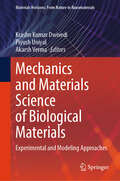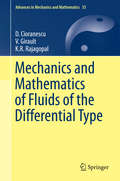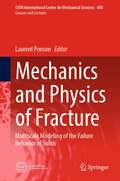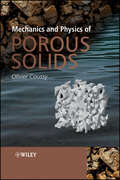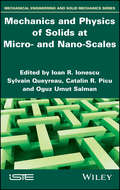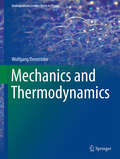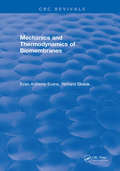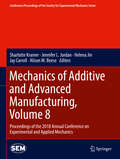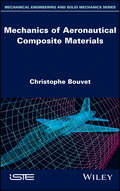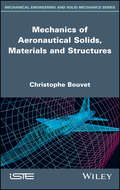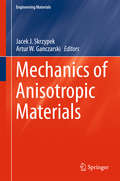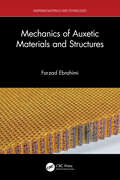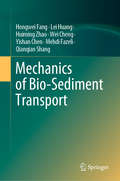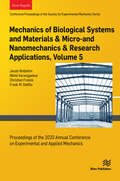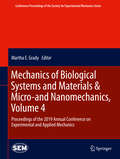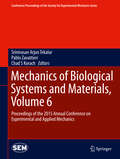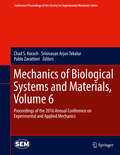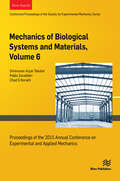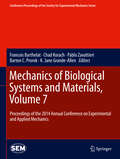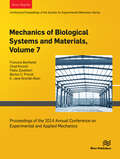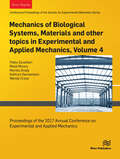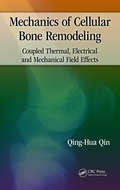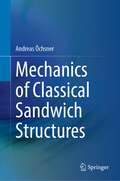- Table View
- List View
Mechanics and Materials Science of Biological Materials: Experimental and Modeling Approaches (Materials Horizons: From Nature to Nanomaterials)
by Akarsh Verma Krashn Kumar Dwivedi Piyush UniyalThis book focuses on the important experimental techniques and modeling approaches, with their technological improvements and recent research advancements in the field of biomechanics. The major aim of this book is to cover all updated aspects of biomechanics and materials science of biological materials and its holistic domains including the history, source, formulations and applications. The emphasis is given on the understanding mechanics of soft and hard tissues. Also, many case studies are incorporated in this book that separates it from other related texts.
Mechanics and Mathematics of Fluids of the Differential Type
by D. Cioranescu V. Girault K. R. RajagopalThis text is the first of its kind to bring together both the thermomechanics and mathematical analysis of Reiner-Rivlin fluids and fluids of grades 2 and 3 in a single book. Each part of the book can be considered as being self-contained. The first part of the book is devoted to a description of the mechanics, thermodynamics and the stability of flows of fluids of grade 2 and grade 3. The second part of the book is concerned with the development of rigorous mathematical results concerning the equations governing the motion of a family of fluids of the differential type. Finally, the proofs of a number of useful results are collected in an appendix.
Mechanics and Physics of Fracture: Multiscale Modeling of the Failure Behavior of Solids (CISM International Centre for Mechanical Sciences #608)
by Laurent PonsonThe volume provides a comprehensive understanding of the macroscopic failure behavior of solids from the description of the microscopic failure processes and their coupling with the microstructure. Several fundamental questions were addressed: the relation between the microstructural features of materials and their fracture properties and crack trajectories; the role of damage mechanisms and non-linear deformations near the crack tip on the failure behavior of solids; and finally the role of dynamic inertial effects during fast fracture was more briefly evoked. The chapters provide a pedagogical overview of recently developed concepts and tools, that permit to perform the transition from small scales to large ones in fracture problems, thus introducing basic rules for the rational design of tough solids.
Mechanics and Physics of Porous Solids
by Olivier CoussyMechanics and Physics of Porous Solids addresses the mechanics and physics of deformable porous materials whose porous space is filled by one or several fluid mixtures interacting with the solid matrix. Coussy uses the language of thermodynamics to frame the discussion of this topic and bridge the gap between physicists and engineers, and organises the material in such a way that individual phases are explored, followed by coupled problems of increasing complexity. This structure allows the reader to build a solid understanding of the physical processes occurring in the fluids and then porous solids.Mechanics and Physics of Porous Solids offers a critical reference on the physics of multiphase porous materials - key reading for engineers and researchers in structural and material engineering, concrete, wood and materials science, rock and soil mechanics, mining and oil prospecting, biomechanics.
Mechanics and Physics of Solids at Micro- and Nano-Scales
by Ioan R. Ionescu Sylvain Queyreau Catalin R. Picu Oguz Umut SalmanChronicling the 11th US–France "Mechanics and physics of solids at macro- and nano-scales" symposium, organized by ICACM (International Center for Applied Computational Mechanics) in Paris, June 2018, this book addresses the breadth of issues raised. It covers a comprehensive range of scientific and technological topics (from elementary plastic events in metals and materials in harsh environments to bio-engineered and bio-mimicking materials), offering a representative perspective on state-of-the-art research and materials. Expounding on the issues related to mesoscale modeling, the first part of the book addresses the representation of plastic deformation at both extremes of the scale – between nano- and macro- levels. The second half of the book examines the mechanics and physics of soft materials, polymers and materials made from fibers or molecular networks.
Mechanics and Thermodynamics
by Wolfgang DemtröderThis introduction to classical mechanics and thermodynamics provides an accessible and clear treatment of the fundamentals. Starting with particle mechanics and an early introduction to special relativity this textbooks enables the reader to understand the basics in mechanics. The text is written from the experimental physics point of view, giving numerous real life examples and applications of classical mechanics in technology. This highly motivating presentation deepens the knowledge in a very accessible way. The second part of the text gives a concise introduction to rotational motion, an expansion to rigid bodies, fluids and gases. Finally, an extensive chapter on thermodynamics and a short introduction to nonlinear dynamics with some instructive examples intensify the knowledge of more advanced topics. Numerous problems with detailed solutions are perfect for self study.
Mechanics and Thermodynamics of Biomembranes
by Eustace Anthony EvansThis tutorial provides an introduction to the determination of mechanical properties of biological membranes and methods of analysis useful in their interpretation. These methods are based on fundamentals of continuum mechanics, thermodynamics, and mechanics of thin shells. This article is intended primarily for engineering and physical scientists who are interested in the physical behaviour and structure of biological membranes.
Mechanics of Additive and Advanced Manufacturing, Volume 8: Proceedings of the 2018 Annual Conference on Experimental and Applied Mechanics (Conference Proceedings of the Society for Experimental Mechanics Series)
by Helena Jin Jay Carroll Alison M. Beese Sharlotte Kramer Jennifer L. JordanMechanics of Additive and Advanced Manufacturing, Volume 8 of the Proceedings of the 2018 SEM Annual Conference & Exposition on Experimental and Applied Mechanics, the eighth volume of eight from the Conference, brings together contributions to this important area of research and engineering. The collection presents early findings and case studies, including: Fatigue & Fracture in AM MaterialsAdditively Manufactured Metals & StructuresAM Process CharacterizationProcessing & Mechanical Behavior of AM MaterialsDynamic Response of AM MaterialsAdditively Manufactured Polymers & Composites
Mechanics of Aero-structures
by Sudhakar NairMechanics of Aero-structures is a concise textbook for students of aircraft structures, which covers aircraft loads and maneuvers, torsion and bending of single cell, multi-cell and open thin-walled structures. Static structural stability, energy methods, and aero-elastic instability are discussed. Numerous examples and exercises are included to enhance the students' facility with structural analysis. This textbook is meant for third- and fourth-year undergraduate students in the aerospace and aeronautical engineering programs, and the material included can be covered in a one semester course. A sufficient number of figures are included for the clarity of the subject matter. The book begins with a description of aerodynamic loads to motivate students, and includes an in-depth description of energy methods - an essential topic.
Mechanics of Aeronautical Composite Materials
by Christophe BouvetThis book presents the principles of composite laminate sizing widely used for composite structures. The focus is on aeronautics in particular, including the concepts of limit loads and ultimate loads. After a brief overview of the main composite materials used in aeronautics, the basic theory of laminated plates and the associated rupture criteria are given. The author presents two fundamental cases of the sizing of aeronautical composite structures: the calculation of the holed structures and their subsequent multi-bolt joints, and the calculation of the buckling. The concept of damage tolerance is also explored, with a focus on its application for tolerance to impact damage. These notions are fundamental for understanding the specificities of the sizing of aeronautical composite structures. The book also contains corrected exercises for the reader to test their understanding of the different topics covered.
Mechanics of Aeronautical Solids, Materials and Structures
by Christophe BouvetThe objective of this work on the mechanics of aeronautical solids, materials and structures is to give an overview of the principles necessary for sizing of structures in the aeronautical field. It begins by introducing the classical notions of mechanics: stress, strain, behavior law, and sizing criteria, with an emphasis on the criteria specific to aeronautics, such as limit loads and ultimate loads.Methods of resolution are then presented, and in particular the finite element method. Plasticity is also covered in order to highlight its influence on the sizing of structures, and in particular its benefits for design criteria.Finally, the physics of the two main materials of aeronautical structures, namely aluminum and composite materials, is approached in order to clarify the sizing criteria stated in the previous chapters.Exercises, with detailed corrections, then make it possible for the reader to test their understanding of the different subjects.
Mechanics of Anisotropic Materials
by Jacek J. Skrzypek Artur W. GanczarskiThe book is focused on constitutive description of mechanical behaviour of engineering materials: both conventional (polycrystalline homogeneous isotropic or anisotropic metallic materials) and non-conventional (heterogeneous multicomponent anisotropic composite materials). Effective material properties at the macro-level depend on both the material microstructure (originally isotropic or anisotropic) as well as dissipative phenomena occurred on fabrication and consecutive loading phase (hardening) resulting in irreversible microstructure changes (acquired anisotropy). The material symmetry is a background and anisotropy is a core around which the book is formed. In this way a revision of classical rules of enhanced constitutive description of materials is required.
Mechanics of Auxetic Materials and Structures (Emerging Materials and Technologies)
by Farzad EbrahimiMechanics of Auxetic Materials and Structures offers a wide range of application-based and practical considerations of smart materials and auxetic materials in engineering structures. Exploring the analytical and numerical solution procedures, the book discusses crucial characteristics of metamaterials and their response to external factors.Covering the effect of different parameters and external factors on the mechanics of auxetic materials and structures, the book considers the benefits leading to better fracture resistance, toughness, shear modulus, and acoustic response.The book serves as a reference for senior undergraduate and graduate students studying civil engineering, mechanical engineering, and materials science and taking courses in smart materials, metamaterials, and mechanics of materials.
Mechanics of Bio-Sediment Transport
by Wei Cheng Hongwei Fang Lei Huang Huiming Zhao Yishan Chen Mehdi Fazeli Qianqian ShangThe main focus of this book is the transport mechanics of sediment particles coated with microbial biofilm, which is called bio-sediment. The book also addresses the question of how to measure and simulate the considerable variation in the properties of natural sediment associated with microbial biofilm, ranging from the micro-scale surface morphology to the macro-scale sediment transport. Nowadays most studies to elucidate the mechanisms of sediment transport have concentrated on physical-chemical sediment properties, little work explicitly coupled sediment dynamics and the environmental effects under the influence of micro-ecosystem, thus leaving a serious gap in water and sediment sciences as well as water ecological research. With respect to physical-chemical sediment properties, this book has been undertaken to evaluate and quantify the effect of biological factors - biofilm on sediment transport mechanics. The chapters cover topics including development of bio-sediment and its properties; model of biofilm growth on sediment substratum; bedform and flow resistance of bio-sediment bed; incipient velocity and settling velocity of bio-sediment; bedload and suspended load transport for bio-sediment; numerical simulation of bio-sediment transport. Besides, the measurement technology, analysis method and expression approach introduced in this book combine the characteristics of hydraulic, environmental and microbial research, having more immediate innovation. This book will be of interest to researchers, managers, practitioners, policy and decision makers, international institutions, governmental and non-governmental organizations, educators, as well as graduate and undergraduate students in the field of hydraulics and river dynamics. It will help to understand the relevance of sediment transport and biofilm growth under the role of aqueous micro-ecosystem, to introduce better tools for the simulation and prediction of bio-sediment transport, and to provide a scientific basis and application foundation for the research of interaction between sediment particles and ecological and environmental factors.
Mechanics of Biological Systems and Materials & Micro-and Nanomechanics & Research Applications: Proceedings of the 2020 Annual Conference on Experimental and Applied Mechanics
by Nikhil Karanjgaokar Jacob Notbohm Christian Franck Frank W. DelRioMechanics of Biological Systems & Micro-and Nanomechanics, Volume 5 of the Proceedings of the 2020 SEM Annual Conference & Exposition on Experimental and Applied Mechanics, the fifth volume of seven from the Conference, brings together contributions to important areas of research and engineering. The collection presents early findings and case studies on a wide range of topics, including: Cell Mechanics & Traumatic Brain Injury Micromechanical Testing Adhesion and Fracture MEMS Devices and Technology Nano-scale Deformation Mechanisms 1D & 2D Materials Tribology & Wear Research and Applications in Progress.
Mechanics of Biological Systems and Materials & Micro-and Nanomechanics & Research Applications: Proceedings of the 2020 Annual Conference on Experimental and Applied Mechanics (Conference Proceedings of the Society for Experimental Mechanics Series)
by Nikhil Karanjgaokar Jacob Notbohm Christian Franck Frank W. DelRioMechanics of Biological Systems & Micro-and Nanomechanics, Volume 5 of the Proceedings of the 2020 SEM Annual Conference & Exposition on Experimental and Applied Mechanics, the fifth volume of seven from the Conference, brings together contributions to important areas of research and engineering. The collection presents early findings and case studies on a wide range of topics, including:Cell Mechanics & Traumatic Brain InjuryMicromechanical TestingAdhesion and FractureMEMS Devices and TechnologyNano-scale Deformation Mechanisms1D & 2D MaterialsTribology & WearResearch and Applications in Progress
Mechanics of Biological Systems and Materials & Micro-and Nanomechanics, Volume 4: Proceedings of the 2019 Annual Conference on Experimental and Applied Mechanics (Conference Proceedings of the Society for Experimental Mechanics Series)
by Martha E. GradyMechanics of Biological Systems and Materials & Micro-and Nanomechanics, Volume 4 of the Proceedings of the 2019 SEM Annual Conference & Exposition on Experimental and Applied Mechanics, the fourth volume of six from the Conference, brings together contributions to important areas of research and engineering. The collection presents early findings and case studies on a wide range of topics, including: Extreme NanomechanicsIn-Situ NanomechanicsExpanding Boundaries in MetrologyMicro and Nanoscale DeformationMEMS for Actuation, Sensing and Characterization1D & 2D MaterialsCardiac MechanicsCell Mechanics Biofilms and Microbe MechanicsTraumatic Brain InjuryOrthopedic BiomechanicsLigaments and Soft Materials
Mechanics of Biological Systems and Materials, Volume 6
by Pablo Zavattieri Chad S. Korach Srinivasan Arjun Tekalur5thInternational Symposium on the Mechanics of Biological Systems and Materials, Volume 6 of the Proceedings of the 2015SEM Annual Conference& Exposition on Experimental and Applied Mechanics, the sixth volume of nine from the Conference, brings together contributions to this important area of research and engineering. The collection presents early findings and case studies on a wide range of areas, including: Soft Tissues Mechanics Bio-Engineering and Biomechanics Natural Materials & Bio-Inspiration Novel Techniques and Experiments in Biomechanics Tissue Engineering Cells Mechanics
Mechanics of Biological Systems and Materials, Volume 6
by Pablo Zavattieri Chad S. Korach Srinivasan Arjun TekalurMechanics of Biological Systems and Materials, Volume 6 of the Proceedings of the 2016 SEM Annual Conference & Exposition on Experimental and Applied Mechanics, the sixth volume of ten from the Conference, brings together contributions to this important area of research and engineering. The collection presents early findings and case studies on a wide range of areas, including: Soft Material Mechanics Bio-Engineering and Biomechanics Cells Mechanics Biomaterials and Mechanics Across Multiple Scales Biomechanics Biotechnologies Traumatic Brain Injury Mechanics
Mechanics of Biological Systems and Materials, Volume 6: Proceedings of the 2015 Annual Conference on Experimental and Applied Mechanics
by Pablo Zavattieri Chad S. Korach Srinivasan Arjun Tekalur5th International Symposium on the Mechanics of Biological Systems and Materials, Volume 6 of the Proceedings of the 2015SEM Annual Conference& Exposition on Experimental and Applied Mechanics, the sixth volume of nine from the Conference, brings together contributions to this important area of research and engineering. The collection presents early findings and case studies on a wide range of areas, including: Soft Tissues Mechanics Bio-Engineering and Biomechanics Natural Materials & Bio-Inspiration Novel Techniques and Experiments in Biomechanics Tissue Engineering Cells Mechanics.
Mechanics of Biological Systems and Materials, Volume 7
by Pablo Zavattieri Barton C. Prorok K. Jane Grande-Allen Francois Barthelat Chad KorachMechanics of Biological Systems and Materials, Volume 7: Proceedings of the 2014 Annual Conference on Experimental and Applied Mechanics, the seventh volume of eight from the Conference, brings together contributions to this important area of research and engineering The collection presents early findings and case studies on a wide range of areas, including: Soft Tissues Mechanics Natural Materials & Bio-Inspiration Tissue Engineering Cells Mechanics
Mechanics of Biological Systems and Materials, Volume 7: Proceedings of the 2014 Annual Conference on Experimental and Applied Mechanics
by Pablo Zavattieri Barton C. Prorok Francois Barthelat Chad Korach Grande-Allen, K. JaneMechanics of Biological Systems and Materials, Volume 7: Proceedings of the 2014 Annual Conference on Experimental and Applied Mechanics, the seventh volume of eight from the Conference, brings together contributions to this important area of research and engineering. The collection presents early findings and case studies on a wide range of areas, including: Soft Tissues Mechanics Natural Materials & Bio-Inspiration Tissue Engineering Cells Mechanics.
Mechanics of Biological Systems, Materials and other topics in Experimental and Applied Mechanics, Volume 4: Proceedings of the 2017 Annual Conference on Experimental and Applied Mechanics
by Pablo Zavattieri Majid Minary Martha Grady Crone, Kathryn Dannemann WendyMechanics of Biological Systems, Materials and other topics in Experimental and Applied Mechanics, Volume 4 of the Proceedings of the 2017 SEM Annual Conference & Exposition on Experimental and Applied Mechanics, the fourth volume of nine from the Conference, brings together contributions to important areas of research and engineering. The collection presents early findings and case studies on a wide range of topics, including: Biological & Biomimetic Materials Cell Mechanics & Traumatic Brain Injury Mechanics of Collagen & Other Proteins Force Generation in Biological Machinery Education & Research in Progress Applications.
Mechanics of Cellular Bone Remodeling: Coupled Thermal, Electrical, and Mechanical Field Effects
by Qing-Hua QinResearch on bone remodeling has resulted in much new information and has led to improvements in design and biomedical practices. Mechanics of Cellular Bone Remodeling: Coupled Thermal, Electrical, and Mechanical Field Effects presents a unified exploration of recent advances, giving readers a sound understanding of bone remodeling and its mathemati
Mechanics of Classical Sandwich Structures
by Andreas ÖchsnerThis book treats the mechanical behavior of one-dimensional sandwich structures, a typicaloncept in the context of lightweight design. Such structures are composed of different constituent (e.g., layers) in order to achieve overall properties, which are better than for a single component alone. This book covers the basic mechanical load cases, i.e., tension/compression, bending, and shear. Based on this knowledge, different failure modes, i.e., plastic yielding, and global and local instabilities are investigated. In addition, an introduction to classic optimization problems, i.e., the formulation of an objective function (e.g., the weight of a structure) and corresponding restrictions, is included. The consideration here is limited to one- or two-dimensional design spaces, i.e., with a maximum of two design variables. For such simple cases, the minimum of the objective function can often be determined using analytical or graphical methods.
